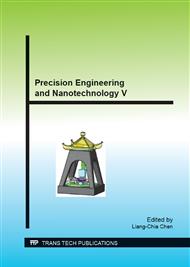p.247
p.253
p.258
p.262
p.267
p.274
p.282
p.288
p.297
Theoretical Analysis about Off-Axis Parabolic Surface Machining under Two Different Accurate Spiral Tool Paths
Abstract:
Off-axis aspheric surface is an indispensable optical device for the high precision measurement and manufacturing equipment, and the tool path generation is a very important factor for the manufacturing to obtain the surface with high precision form and nanometric surface finish. In this paper, the systemic description of tool path generation method about the off-axis parabolic surface with ultra-precision single point diamond turning is processed. Two effective methods of generating the accurate spiral tool path are proposed and compared. The proposed methods are mainly based on mathematical calculation directly from analytic surfaces, including the general process of tool path generation, cutting-tool compensation and avoiding tool interference. This work can provide the theoretical basis of choosing the cutting tool path for off-axis parabolic surface and can improve the efficiency and precision of machine. Finally, some cutting simulations are implemented to prove the proposed methods.
Info:
Periodical:
Pages:
267-273
Citation:
Online since:
August 2014
Authors:
Price:
Сopyright:
© 2015 Trans Tech Publications Ltd. All Rights Reserved
Share:
Citation:


